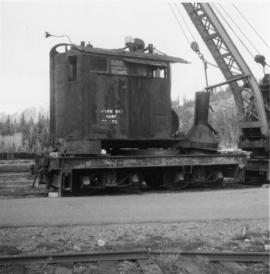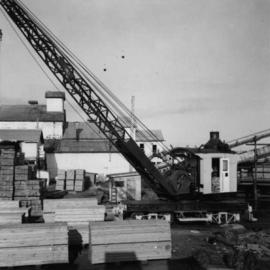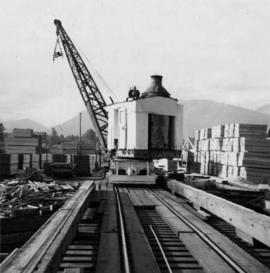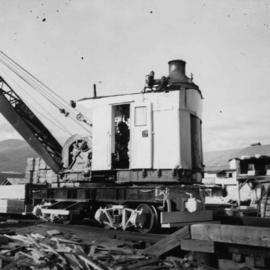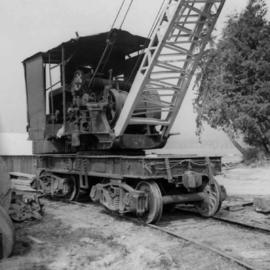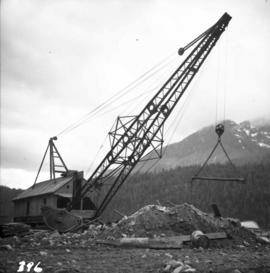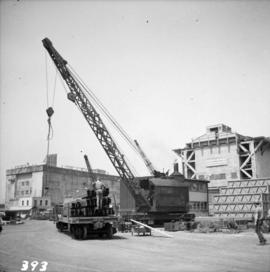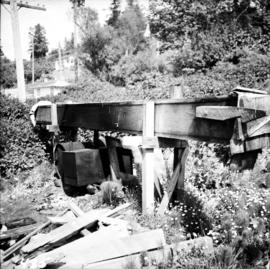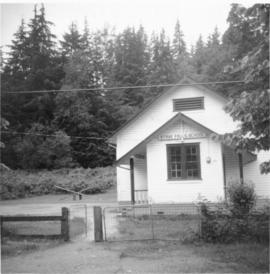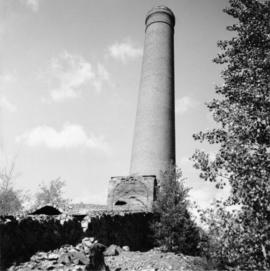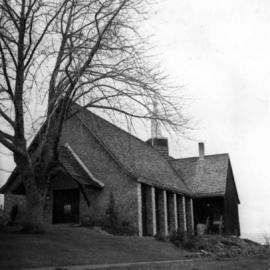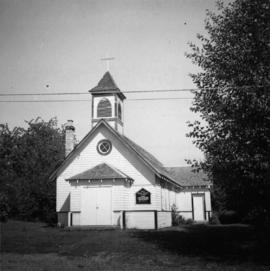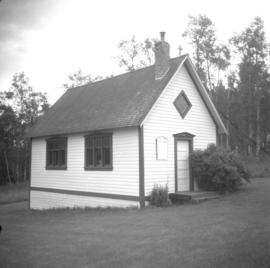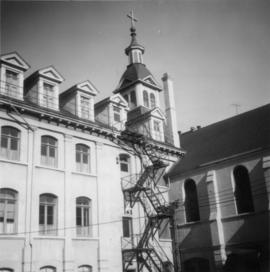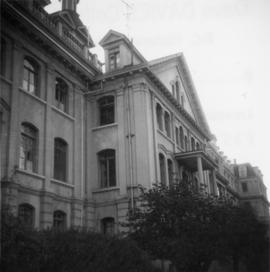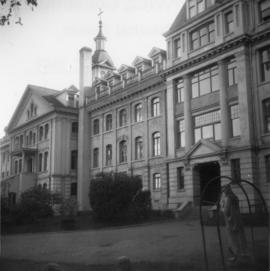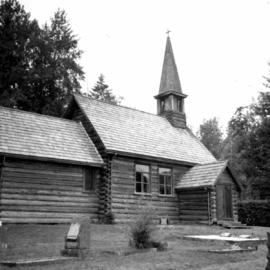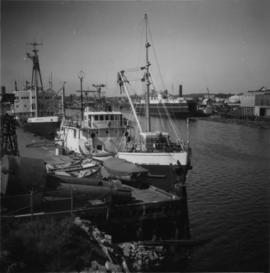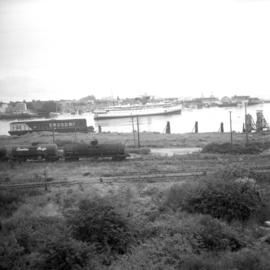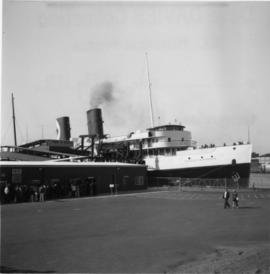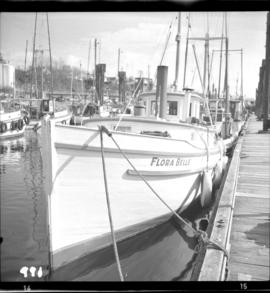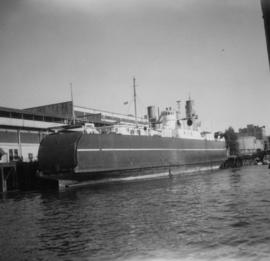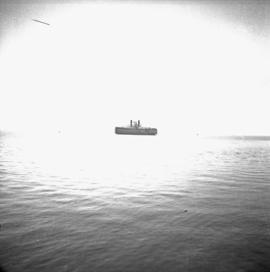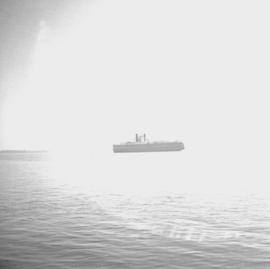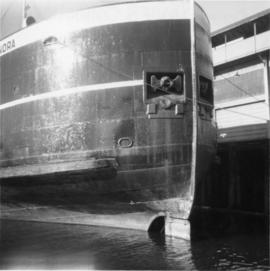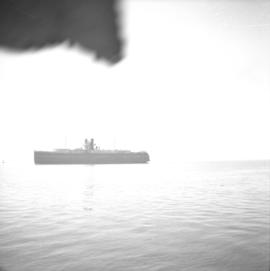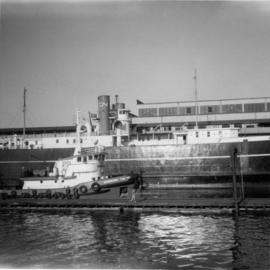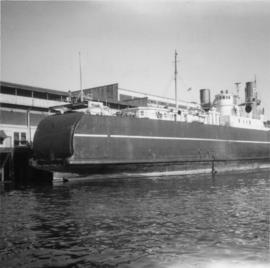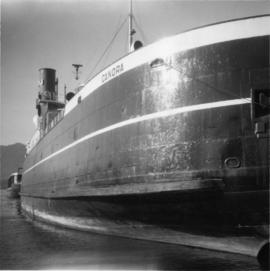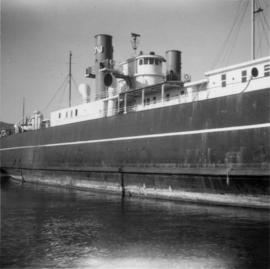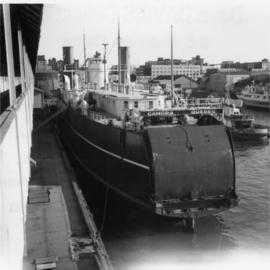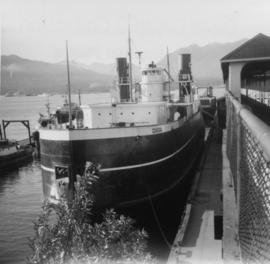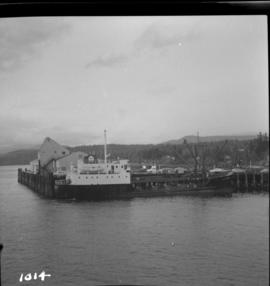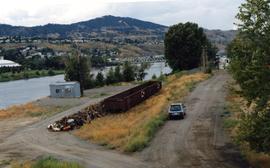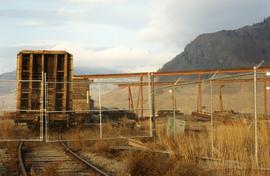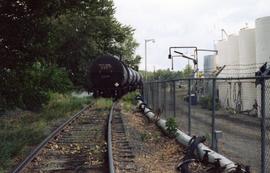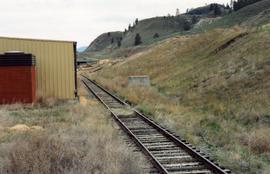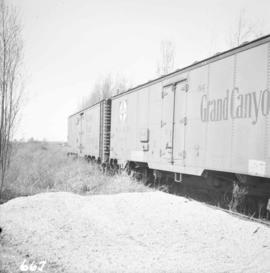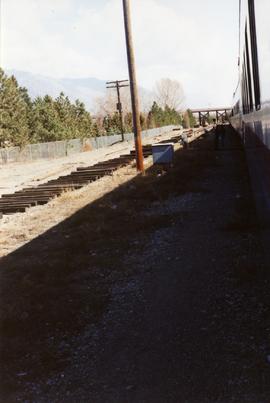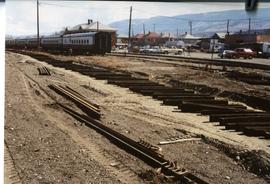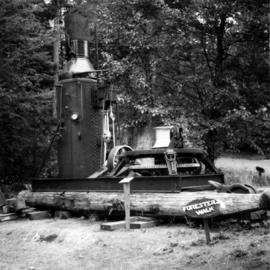Photograph depicts a steam crane, lettered "Osborn Bay Wharf Ltd." Davies suggests that it may have been on the Victoria-Pacific tourist line on the outskirts of Victoria.
Photograph depicts a steam crane in the yard of the Lions Gate Lumber Co. at the foot of Lloyd St. in North Vancouver. The crane was made by the Brown Hoisting Machinery Co. in Cleveland, Ohio and is undated. It has a 20 ton capacity, is well maintained, and freshly painted.
Photograph depicts a steam crane in the yard of the Lions Gate Lumber Co. at the foot of Lloyd St. in North Vancouver. It is used to load scows from stacks shown to left and right of track. Thick baulks of timber on edges of pier are part of a safety device. Crane has transverse underframe which just clears these baulks normally. Under a heavy load and extended jib the underframe rests on the baulks.
Photograph depicts a steam crane in the yard of the Lions Gate Lumber Co. on the foot of Lloyd St. in the North Vancouver. It has been freshly painted with a yellow exterior, white interior, and black boiler.
Photograph depicts a steam crane in a lumber yard on the north side of Porpoise Bay in Sechelt on the Sechelt Peninsula. The steam crane has been converted to diesel and was made by the Brown Hoisting Co. from Cleveland, Ohio. It lifts 21 tons at a 12ft radius and 5 tons at 35ft radius, and is in daily use. The 200 yards of rail track form a "Y" with the bottom piece onto the wharf.
Photograph depicts a recently used steam crane, but driven by compressed air, at a former quarry at Granite Falls on the northeast end of the Indian Arm. The timbers on of the cabin were thick to withstand the blasting rock falls.
Photograph depicts a steam crane at the Allied Shipbuilders Ltd. on 145 West First Ave in Vancouver, BC
Photograph depicts a steam box for bending ships' timbers. It is located at River Road in north Surrey, opposite Annacis Island.
Photograph depicts Stave Falls School, a type of rural school that was falling into disuse. This one was still in use and cared for.
Series consists of material regarding railway stations in British Columbia. Includes information about station furnishing, architectural history, flagstops, and railway station gardens. Also contains details about specific stations and types of stations built by each railway in British Columbia, including stations built by the Canadian Pacific Railway, the Canadian National Railway, the Esquimalt & Nanaimo Railway, the Pacific Great Eastern Railway, and the Great Northern Railway.
Photograph depicts the close up of the stack, whistle, and wheelhouse of the S.S. Flora Bell in Westview Harbour, Powell River.
Photograph depicts a 120 ft. stack of the former B.C. Copper Company in Anaconda, on the outskirts of Greenwood. It was built sometime between 1903 and 1909 and replaced a steel stack built on 1900, immediately below it.
Photograph depicts St. Paul's Anglican Church in Powell River. The church was built in 1955.
Photograph depicts St. Margaret's Anglican Church on Bradner Rd., 3 miles northeast of Aldergrove in the Fraser Valley.
Photograph depicts St. John the Divine church, built in 1914 at Hubert which is now a ghost town. Moved to this location in the open country in 1928.
Photograph depicts St. Hilda's Anglican Church in Sechelt on the Sechelt Peninsula. Tall tree on left just coming into flower is a dogwood.
Photograph depicts the St. Helen's Anglican Church on Old Yale Rd. (overlooking the Patullo Bridge) in South Westminster, Surrey.
Photograph depicts St. Ann's Academy, a girls boarding school. In the distance, a graceful spire marks the highest point of the building.
Photograph depicts St. Ann's Academy, a girls boarding school that was close to the centre of Victoria. In the corner of the property, nuns had established the first school in B.C. in 1853.
Photograph depicts St. Ann's Academy, a girls boarding school that was close to the centre of Victoria. Captured the front of the main building.
Photograph depicts St. Anne's log church on French Creek, near Parksville on Vancouver Island. The church was built in 1894 and was still in use at the time.
Photograph depicts "SS Sir James Douglas," a Coastguard supply vessel, built in 1956. Astem from her is "Camsell," a full ice breaker, built in 1959. Out-of-service is CNR "SS Canora" is found in the background.
Photograph depicts the "SS Patricia" leaving for Seattle. Esquimalt & Nanaimo Railway trackage is visible in the foreground. Three water tank cars used for fire fighting are on the left of the picture.
Photograph depicts "SS Princess Marguerite." Passengers and cars were being loaded to return to Seattle.
Photograph depicts the S.S. Flora Bell in Westview Harbour, Powell River. It is a steam boat with a vertical tube boiler and driven by a 2 cylinder reciprocating steam engine which came from a U.S. navy pinnace. The engine was built in 1919 at Mare's Island Naval Shipyard in California. The boat runs at about 6 knots.
Photograph depicts "Canora," a CNR rail car ferry that was taken out of service in 1967.
Photograph depicts "Canora," a CNR rail ferry.
Photograph depicts "Canora," a CNR rail ferry.
Photograph depicts "Canora," a CNR rail ferry that had recently retired from the Fraser River-Victoria ferry run. Visible are details of its bow and rudder and unseen propeller.
Photograph depicts "Canora," a CNR rail ferry.
Photograph depicts "Canora," a CNR rail ferry that had recently retired from Georgia Strait ferry work. The lowest deck contained the engine room. The next deck contained a rail car deck with 4 tracks, while the upper deck consisted of the crew quarters held in flat top cabins, as shown.
Photograph depicts "Canora," a CNR rail ferry that was recently put out of service.
Photograph depicts "Canora," a CNR rail ferry.
Photograph depicts "Canora," a CNR rail ferry that was recently retired from Fraser River-Victoria rail ferry work. Looking towards stern with the bow in the foreground.
Photograph depicts "Canora," a CNR rail ferry that had recently taken off of the Tilbury-Victoria run because of relatively high operating costs.
Photograph depicts "Canora," a CNR rail ferry that had recently been taken out of service. Shown is the massive rolling stern door which was raised by steam winches mounted above on the open upper deck.
Photograph depicts "Canora," a CNR rail car ferry that was taken out of service in 1967.
Photograph depicts the S.S. "BC Standard" at Westview Harbour, Powell River. The ship was registered in Vancouver.
Map depicts the City of Squamish, Howe Sound, and the Britannia Mine.
Photograph depicts a spur that terminated close to Red Bridge on the north side of Thompson River. This end section of 200 yards had not been in use for at least 15 years. For 2-3 months near the date the photograph was taken, it was used to load scrap metal.
Photograph depicts Wilkinson Steel Ltd. The spur was serviced by CN. Visible is an empty bulkhead car that had recently been brought in for its steel.
Photograph depicts a spur located next to Pounder Emulsions Ltd. Electric capstan (Jeffrey Electric Co, Montreal) used to move full and empty tank cars of bitumen (for blacktops). Did not appear to be used.
The building of this spur in 1977 was a late and short lived attempt to move yearling cattle to Ontario for fattening by rail. The Last stock train ran in 1985. The CN rail track was still in use in August 1998. This photograph shows the spur running east and down grade to a stockyard owned by BC Interior Cattlemen's Association. Additional information is available in article, "Moving Livestock by Rail: An inquiry into an extinct traffic" in The Sandhouse journal, Issue 121, Spring 2006.
Photograph depicts a spur leading off the Canadian National Railway (CN) spur to the Lafarge Cement Plant on the south bank and east side of Lulu Island. This spur used to be the original line and led to a peat plant, just seen at left on the horizon. The second car is pushed onto unused and overgrown track, which is dated 1909 Algoma Steel. This siding much used.
Photograph depicts the laying of an extra spur for passenger car storage of Rocky Mountaineer Rail Tours at the CN Downtown Depot in Kamloops.
Photograph depicts the laying of an extra spur for passenger car storage of Rocky Mountaineer Rail Tours at the CN Downtown Depot in Kamloops.
Photograph depicts an early spool donkey at the Cowichan Valley Forest Museum
Postcard depicts spiral tunnels.
Postcard depicts a spiral tunnel near Field, in which trains make a complete turn around the Canadian Rockies. One of two spiral tunnels, and the first of this system introduced on the continent. The greatest pieced of tunnelling ever attempted in Canada. Cost 1,5000,000. Time of work: 20 months. 75 car-loads of dynamite used.
Postcard depicts one of the spiral tunnels that was constructed in 1909. Built by 1000 men who worked for 2 years to complete it.
